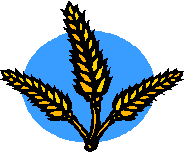

To send a message to an author, click on the author's name at the end of the article.
This Month in Ag Connection | Ag Connection - Other Issues Online
What do baseball and "grain quality" have in common? Answer: A grand slam is a very good thing. Years ago, the term SLAM started appearing in farm news as a post harvest IPM strategy to maximize grain quality and profits. Co-developed by Oklahoma State University and Purdue University, the proactive steps outlined in the SLAM formula seek to prevent pest problems before they arise.

The term SLAM, sometimes written S.L.A.M., comes from the following four basic principles outlined in the method: sanitation, loading, aeration and monitoring. While it's still early fall, take a closer look at the first principle - sanitation.
Sanitation refers to the primary steps involved in preparing equipment, bin and bin sites for the new crop. Sanitation begins and ends with cleaning. It's always important to keep the bin site free of spilled grain, weeds and other vegetation, but it's particularly important in preparation for receiving new crop. Likewise, it's a good idea to thoroughly clean combines, trucks and all grain handling equipment.
Routine cleaning of unloading pits, elevator legs and augers helps to avoid forgotten piles of grain that can spoil or make a home for grain pests. Leftover grain anywhere in the handling system can act as an inoculant to contaminate new grain. To facilitate routine cleaning, design new facilities with easily accessed cleanout panels at transition points such as the bottom of elevator legs and anywhere grain may collect in the system. Use self-cleaning components wherever possible to ease the chore and to make cleanout more complete.
Extended storage times may require the walls and other parts of grain structures to be treated with residual insecticides. Insects will eventually find stored grain. Wayne Bailey, State Extension Entomologist, maintains a good summary of stored grain insect management available at the following website: http://agebb.missouri.edu/storage/pests/insect.htm.
Visit http://www.extension.purdue.edu/extmedia/ID/ID-207.html for the original publication describing the S.L.A.M. strategy.
(Author: Bill Casady, Extension Ag Engineer, casadyw@missouri.edu, (573) 882-4370)
This Month in Ag Connection | Ag Connection - Other Issues Online
Most people are familiar with sales tax, but what about use tax. Is "sales tax" collected on certain types of sales or services and "use tax" on others? Are "sales tax" and "use tax" just different names for the same tax?

Sales tax is collected on most sales of tangible personal property and certain services. The Missouri state sales tax rate is 4.225 percent. Entities making retail sales within Missouri collect the sales tax from the purchaser and remit the tax to the Missouri Department of Revenue (MO-DOR).
Use tax is imposed on the use, storage or consumption of tangible personal property shipped into Missouri from outside the state. The Missouri use tax is the same rate as the sales tax rate, i.e. 4.225 percent. Some out-of-state vendors collect and remit the use tax directly to the MO-DOR. The purchaser is responsible for remitting the tax to the MO-DOR if the out-of-state vendor does not collect the use tax. If you have cumulative taxable purchases of less than $2,000 for the calendar year from out-of-state vendors you are exempted from filing the Use Tax Form 53U-1. States cannot require out-of-state entities that do not have a nexus (direct connection) within the state to collect and remit use tax.
Examples of out-of-state vendors are mail order catalogs (Cabellas, Gemplers, L.L. Bean, etc.) Internet purchases and out-of-state retail outlets. In summary, sales tax is associated with sales occurring within Missouri, while use tax is applicable to sales from vendors located outside Missouri.
(Author: Parman R. Green, Ag Business Management Specialist)
This Month in Ag Connection | Ag Connection - Other Issues Online

Alflatoxin is produced by the fungus Aspergillus flavus (Af). Aflatoxin is a concern to livestock producers since only a few parts per billion (ppb) of aflatoxin in feed can cause serious illness. Grain will be rejected at the elevator if found to have 20 ppb of aflatoxin.
The fungus is stimulated by hot, dry conditions and the crop damage caused by an associated drought. Drought conditions in central Missouri should alert local farmers to be aware of this problem. Farmers need to remember that this fungus will multiply in improperly stored grain more easily than in the field. Drought damage along with insect, bird, or mechanical damage to the grain produces conditions that allow this fungus to grow.
Steps to reduce the chance of aflatoxin contaminated grain are:
Samples for aflatoxin testing can be submitted to: The Veterinary Medical Diagnostic Laboratory, College of Veterinary Medicine. Contact your local veterinarian, extension center or call the diagnostic lab for instructions. (573) 882-6811. There is a fee of $20 for a qualitative analysis and $25 for a quantitative analysis of aflatoxin.
The Missouri Department of Agriculture is also offering aflatoxin testing for $21.00 per test. Phone: (573) 751-5515. Grain samples should be representative.
(Author: Jim Jarman, Agronomy Specialist)
This Month in Ag Connection | Ag Connection - Other Issues Online
Drought conditions may encourage livestock to consume toxic plants as pasture conditions deteriorate. When possible, avoid turning livestock into pastures where poisonous plants occur. Feeding hay, green chop or silage containing poisonous plants is risky. The primary forage may mask the poisonous plants encouraging livestock to consume toxic levels.
Poisonous plants commonly have a disagreeable taste that usually keeps livestock from grazing them. Drought stressed forage and overgrazing may force livestock to try plants they usually avoid. Several species of poisonous plants are distributed throughout Missouri, and many of them are commonly found in native and improved pastures. More detailed information can be obtained from your local extension office. Ask for UMC Guide G4970 "Plants Poisonous to Livestock".
(Author: Jim Jarman, Agronomy Specialist)
This Month in Ag Connection | Ag Connection - Other Issues Online

Grain trucks may be one of the most neglected pieces of equipment on the farm and many are accidents waiting to happen. Before using grain trucks this fall, check the following:
(Author: Don Day, Natural Resource Engineer/Information Technology Specialist)
This Month in Ag Connection | Ag Connection - Other Issues Online
TALL FESCUE NOVEL ENDOPHYTE TRIAL
The Novel endophyte fescue forage plot was
established on September 12, 2001. The plots were fertilized in the fall
of 2002 with 30-60-60. On April 8, 2003 an additional 60 lbs/acre of
nitrogen was applied. The plots survived the winter well and had excellent
spring growth. The plots were harvested May 21, 2003 for yield. The data
presented below is adjusted to 20% moisture.
| YIELD (tons/acre) |
|
|---|---|
| Mac | 2.63 |
| MaxQ | 2.52 |
| Bluegrass mix | 2.13 |
LESPEDEZA TRIALS
The lespedeza trials were established on
May 3, 2002. No harvests were made in 2002. The plots were fertilized in
the fall of 2002 with 0-60-60. The plants were allowed to go to seed in
the fall of 2002. In the spring of 2003, it was noted that an excellent
stand of lespedeza was reestablished. There have been some problems with
both winter and spring annual weeds and these have been controlled to some
extent by hand weeding. To date all plots look good. It is difficult to
see any differences at this point in time. In visiting the plots on July
31, 2003, the plants were beginning to die. The moisture shortage was
becoming severe in the area and no pests or diseases could be found on the
plants. Due to the deteriorating condition of the crop, the plots were
harvested for yield. When the samples are dried, the yields will be figured.
SEEDED BERMUDAGRASS VARIETY TRIAL
These plots were established on May 22, 2002. Varieties included were Wrangler, Guymon, and Cheyenne. The plots
were fertilized with 30-60-60 in the fall of 2002. On May 7, 2003 after
the bermudagrass started growing, the plots had 100 lb/ac of nitrogen
applied. The plots are thin and did not grow as fast as the sprigged
plots. First harvest of these plots occurred on July 15, 2003.
SPRIGGED BERMUDAGRASS PLOTS
These plots were established on June 7, 2002. Varieties included were Hardie, Ozarka and Midland 99. The plots
looked thin in the fall but fairly healthy. The plots had 30-60-60 applied
in the fall. On May 7, 2003, the plots had 100 lbs/ac of nitrogen applied
after the plants broke dormancy. The first harvest of these plots occurred
on June 12 when the plants were just beginning to show seed heads. After
the plots were harvested, another 50 lbs/ac of N was applied to each plot.
Yields for the first harvest (adjusted to 20% moisture) are below.
| YIELD (tons/acre) |
|
|---|---|
| Midland 99 | 0.79 |
| Ozarka | 1.49 |
| Hardie | 0.79 |
Throughout the growing season and last fall, Ozarka appeared to have the best growth and the yield data confirmed that. Second harvest of these plots was on July 31, 2003. Ozarka looked good again, but overall, yields were reduced due to dry weather.
HYBRID BERMUDAGRASS PLOTS
These plots were established in 1995. In the fall of 2002, they received 30-60-60. On May 7, 2003 they had 100
lbs/ac of nitrogen applied. Yields were taken on June 12, 2003. An
additional 50 lbs/ac of nitrogen was applied after harvest. Yield
(adjusted to 20% moisture) for the first cutting is listed below.
| YIELD (tons/acre) |
|
|---|---|
| Greenfield | 2.43 |
| Hardie | 1.90 |
| Guymon | 2.18 |
| Tifton 44 | 2.37 |
| Midland | 1.83 |
All of this year's data is just one harvest. We will continue harvest as indicated by plant growth and provide a summary in the fall of all data accumulated this year. The plots are trimmed about once a month and are available for use by anyone with a little notice. Wesley Tucker has been assisting in activities on the plots and his assistance is appreciated.
(Author: Wayne Crook, Agronomy Specialist)
This Month in Ag Connection | Ag Connection - Other Issues Online
Publishing Information
Ag Connection is published monthly for Northeast and Central areas of Missouri producers and is supported by the University of Missouri Extension, the Missouri Agricultural Experiment Station, and the MU College of Agriculture, Food and Natural Resources. Managing Editor: Mary Sobba.